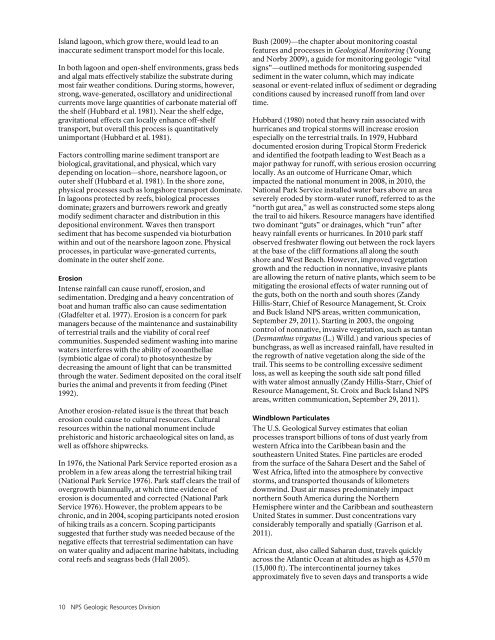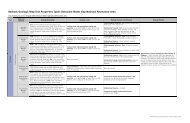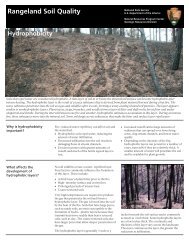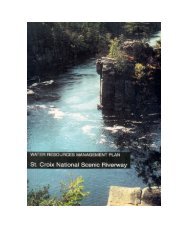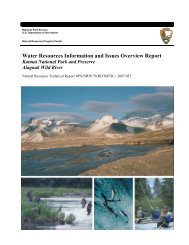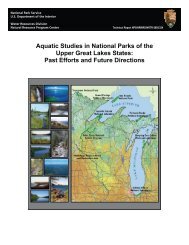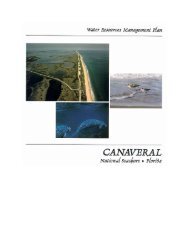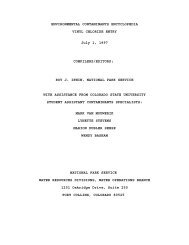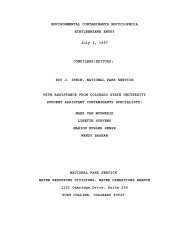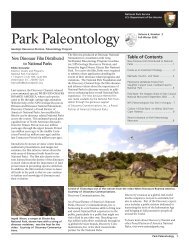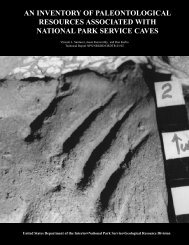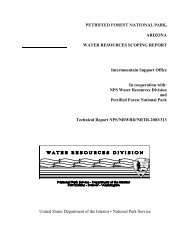Buck Island Reef National Monument Geologic Resources Inventory
Buck Island Reef National Monument Geologic Resources Inventory
Buck Island Reef National Monument Geologic Resources Inventory
Create successful ePaper yourself
Turn your PDF publications into a flip-book with our unique Google optimized e-Paper software.
<strong>Island</strong> lagoon, which grow there, would lead to an<br />
inaccurate sediment transport model for this locale.<br />
In both lagoon and open-shelf environments, grass beds<br />
and algal mats effectively stabilize the substrate during<br />
most fair weather conditions. During storms, however,<br />
strong, wave-generated, oscillatory and unidirectional<br />
currents move large quantities of carbonate material off<br />
the shelf (Hubbard et al. 1981). Near the shelf edge,<br />
gravitational effects can locally enhance off-shelf<br />
transport, but overall this process is quantitatively<br />
unimportant (Hubbard et al. 1981).<br />
Factors controlling marine sediment transport are<br />
biological, gravitational, and physical, which vary<br />
depending on location—shore, nearshore lagoon, or<br />
outer shelf (Hubbard et al. 1981). In the shore zone,<br />
physical processes such as longshore transport dominate.<br />
In lagoons protected by reefs, biological processes<br />
dominate; grazers and burrowers rework and greatly<br />
modify sediment character and distribution in this<br />
depositional environment. Waves then transport<br />
sediment that has become suspended via bioturbation<br />
within and out of the nearshore lagoon zone. Physical<br />
processes, in particular wave-generated currents,<br />
dominate in the outer shelf zone.<br />
Erosion<br />
Intense rainfall can cause runoff, erosion, and<br />
sedimentation. Dredging and a heavy concentration of<br />
boat and human traffic also can cause sedimentation<br />
(Gladfelter et al. 1977). Erosion is a concern for park<br />
managers because of the maintenance and sustainability<br />
of terrestrial trails and the viability of coral reef<br />
communities. Suspended sediment washing into marine<br />
waters interferes with the ability of zooanthellae<br />
(symbiotic algae of coral) to photosynthesize by<br />
decreasing the amount of light that can be transmitted<br />
through the water. Sediment deposited on the coral itself<br />
buries the animal and prevents it from feeding (Pinet<br />
1992).<br />
Another erosion-related issue is the threat that beach<br />
erosion could cause to cultural resources. Cultural<br />
resources within the national monument include<br />
prehistoric and historic archaeological sites on land, as<br />
well as offshore shipwrecks.<br />
In 1976, the <strong>National</strong> Park Service reported erosion as a<br />
problem in a few areas along the terrestrial hiking trail<br />
(<strong>National</strong> Park Service 1976). Park staff clears the trail of<br />
overgrowth biannually, at which time evidence of<br />
erosion is documented and corrected (<strong>National</strong> Park<br />
Service 1976). However, the problem appears to be<br />
chronic, and in 2004, scoping participants noted erosion<br />
of hiking trails as a concern. Scoping participants<br />
suggested that further study was needed because of the<br />
negative effects that terrestrial sedimentation can have<br />
on water quality and adjacent marine habitats, including<br />
coral reefs and seagrass beds (Hall 2005).<br />
Bush (2009)—the chapter about monitoring coastal<br />
features and processes in <strong>Geologic</strong>al Monitoring (Young<br />
and Norby 2009), a guide for monitoring geologic “vital<br />
signs”—outlined methods for monitoring suspended<br />
sediment in the water column, which may indicate<br />
seasonal or event-related influx of sediment or degrading<br />
conditions caused by increased runoff from land over<br />
time.<br />
Hubbard (1980) noted that heavy rain associated with<br />
hurricanes and tropical storms will increase erosion<br />
especially on the terrestrial trails. In 1979, Hubbard<br />
documented erosion during Tropical Storm Frederick<br />
and identified the footpath leading to West Beach as a<br />
major pathway for runoff, with serious erosion occurring<br />
locally. As an outcome of Hurricane Omar, which<br />
impacted the national monument in 2008, in 2010, the<br />
<strong>National</strong> Park Service installed water bars above an area<br />
severely eroded by storm-water runoff, referred to as the<br />
“north gut area,” as well as constructed some steps along<br />
the trail to aid hikers. Resource managers have identified<br />
two dominant “guts” or drainages, which “run” after<br />
heavy rainfall events or hurricanes. In 2010 park staff<br />
observed freshwater flowing out between the rock layers<br />
at the base of the cliff formations all along the south<br />
shore and West Beach. However, improved vegetation<br />
growth and the reduction in nonnative, invasive plants<br />
are allowing the return of native plants, which seem to be<br />
mitigating the erosional effects of water running out of<br />
the guts, both on the north and south shores (Zandy<br />
Hillis-Starr, Chief of Resource Management, St. Croix<br />
and <strong>Buck</strong> <strong>Island</strong> NPS areas, written communication,<br />
September 29, 2011). Starting in 2003, the ongoing<br />
control of nonnative, invasive vegetation, such as tantan<br />
(Desmanthus virgatus (L.) Willd.) and various species of<br />
bunchgrass, as well as increased rainfall, have resulted in<br />
the regrowth of native vegetation along the side of the<br />
trail. This seems to be controlling excessive sediment<br />
loss, as well as keeping the south side salt pond filled<br />
with water almost annually (Zandy Hillis-Starr, Chief of<br />
Resource Management, St. Croix and <strong>Buck</strong> <strong>Island</strong> NPS<br />
areas, written communication, September 29, 2011).<br />
Windblown Particulates<br />
The U.S. <strong>Geologic</strong>al Survey estimates that eolian<br />
processes transport billions of tons of dust yearly from<br />
western Africa into the Caribbean basin and the<br />
southeastern United States. Fine particles are eroded<br />
from the surface of the Sahara Desert and the Sahel of<br />
West Africa, lifted into the atmosphere by convective<br />
storms, and transported thousands of kilometers<br />
downwind. Dust air masses predominately impact<br />
northern South America during the Northern<br />
Hemisphere winter and the Caribbean and southeastern<br />
United States in summer. Dust concentrations vary<br />
considerably temporally and spatially (Garrison et al.<br />
2011).<br />
African dust, also called Saharan dust, travels quickly<br />
across the Atlantic Ocean at altitudes as high as 4,570 m<br />
(15,000 ft). The intercontinental journey takes<br />
approximately five to seven days and transports a wide<br />
10 NPS <strong>Geologic</strong> <strong>Resources</strong> Division


